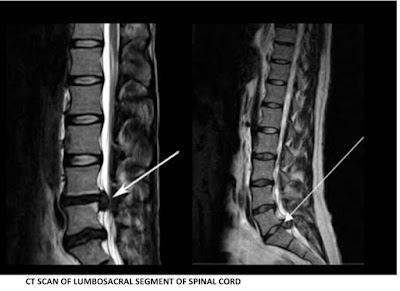CAUDA EQUINA SYNDROME
●INTRODUCTION -
Cauda equina - the peripheral bundle of nerve root originating from the lumbosacral silent of spinal cord.
●DEFINITION-
Cauda equina syndrome is caused by a significant narrowing of spinal canal that compresses the spinal cord and causes nerve problems below the level of compression.
●ETIOlOGY-
1. Central disc herniation
2. Spinal tumours
3. Spinal abscess
4. Meningitis
5. spinal haematomas/ haemorrhage
6. spinal trauma with a burst fracture
7. Spondylolisthesis
8. Spinal stenosis
9. spinal anaesthesia
10. post operative spinal surgery and complications
11. ankylosing Spondylitis
12. spinal malformation
●SYMPTOMS -
Bladder disturbance..
• Urination different to normal
• Inability to start, stop or control urination
• Loss of nerve sensation when urination
• Loss of full bladder sensation
• Inability to empty bladder fully
Bowel function effect..
• Loss of feeling when passing a bowel motion
• Constipation
• Loss of control of bowel movement
Saddle numbness..
• Loss of feeling between the legs
• Numbness in and around the genitals / anus
• Loss of feeling of toilet paper when wiping
Sexual dysfunction..
• Loss of sensation during sexual intercourse
• Inability to achieve an erection or ejaculate
• Loss of clitoral sensation
● Low back pain/ leg/weakness and sciatica..
A combination of this problem may be present. Keep a look out for bilateral toe extensor/ flexor weakness. this can occur before other muscle weakness.
Marked inability to blend forward with back pain /sciatica and leg weakness may indicate a large Disc prolapse anal sphincter reflex may be effected look out for bilateral achilles reflect abscess.
●INVESTIGATION -
●PHYSICAL EXAMINATION -
1. LMN sign
2. Saddle anesthesia
3. Sexual, bowel or bladder dysfunction
4. Gait ataxia
PATHOLOGICAL INVESTIGATION -
1. MRI
2. CTScan
3. AP, lateral, oblique, flexion and extension view x-rays of the lumbosacral spine
4. Urodynamic studies may assess for bladder function subacutely.
5. Blood – FBC
LFT
CRP
●DIFFERENTIAL DIAGNOSIS -
1. Conus medullaris syndrome
2. Herniated nucleus pulposus
3. Spinal stenosis
4. Vertebra fracture
5. Multiple stenosis
6. Peripheral nauropathy
7. Lumbosacral plexopathy
8. Spinal tumor
●TREATMENT-
1. MEDICINAL-
• Treat any underlying cause of compression
• If infected condition – use antibiotics
• If inflammatory condition – use anti-inflammatory
• Pain management
2. SURGICAL TREATMENT -
• Immediate neurosurgeon consulting, surgical decompression may be the only chance to reverse the deficits, which are not always reversible.
• Malignant disease that is considered inoperable may be treated with radiation therapy and chemotherapy.
• Ideally the treatment should occurs within the 48hrs after symptoms onset.
• Spinal immobilization
• Surgical decompression
• Drainage
• Laminectomy
• Fixation of fracture
• Removal of foreign body
●PREVENTION –
• Control of any predisposing underlying pathology
• Early diagnosis and treatment are crucial











0 टिप्पणियाँ